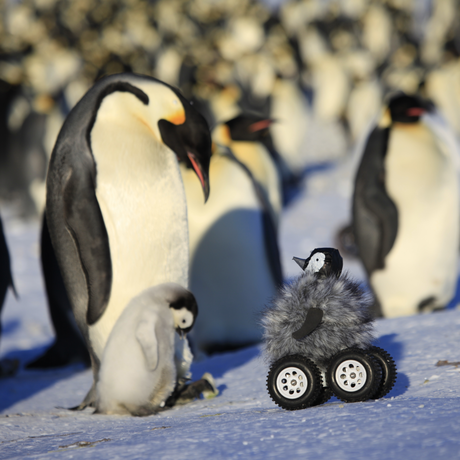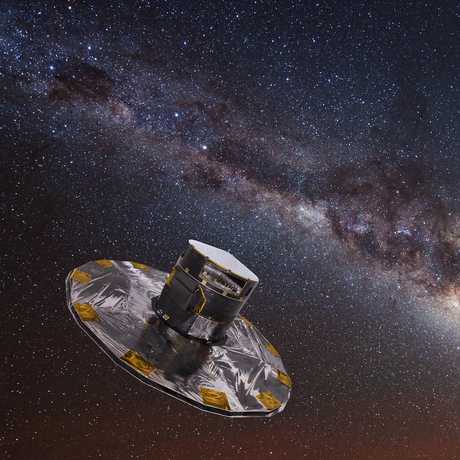Science News
A Martian Mystery, Phobos, Starspots, and Two Trillion Galaxies

Opportunity Sets Its Sights on a Martian Mystery
NASA’s MER-B rover, also known as Opportunity, has been roaming Mars for the past 12 years after landing in 2004. Given an initial design lifespan of 90 days, Opportunity and its counterpart—MER-A, or Spirit—far exceeded expectations. In 2010, Spirit finally gave up the ghost, lasting more than 20 times longer than expected. Opportunity more than doubled Spirit’s lifetime, capturing the title for longest-lived robot on the Red Planet’s surface. Since Opportunity’s arrival, it has explored successively larger craters—130-meter (426-foot) wide Endurance, 730-meter (2,400-foot) wide Victoria, and 22-kilometer (14-mile) wide Endeavour—discovered a half-dozen fallen meteorites, found evidence of flowing water, and broke the record for distance travelled on the surface of another world, passing 42 kilometers (26 miles) in 2015.
And it hasn’t stopped yet.
Every two years, Opportunity’s marathon mission is evaluated, and if everything still looks healthy, its extended. The latest extension began on October 1, and it includes a highly-anticipated foray into a nearby gully to the south that is believed to have been carved by flowing liquid. On September 16, Science Today covered the reason Opportunity’s bigger, more advanced, nuclear-powered cousin, Curiosity (which has its own Twitter account), is being kept away from recurring slope lineae near its landing site in Gale Crater: the liquid that formed the lineae may still be present on a seasonal basis, and scientists are hesitant to contaminate it with any Earthly microbes that may be hitching a ride aboard the rover.
In the case of the gullies, however, the liquid flow that formed them is thought to have taken place farther back in the past—perhaps several million years ago—and presumably, there’s no liquid there today, but scientists aren’t really certain whether the liquid was water or carbon dioxide. Then again, perhaps liquid wasn’t involved at all.
The plan is for Opportunity to drive the full length of the 200-meter (600-foot) gully down into Endeavour crater, the rim of which it has been investigating for the past five years. But even reaching the gully will be a challenge: “Oppy,” as the rover is affectionately known to some, will first have to traverse about a kilometer (roughly a half-mile) of rugged landscape. At its best, it covered 178 meters (582 feet) in one day in 2005, but eleven years later, it’s showing signs of age—experiencing increasing difficulty weathering the Martian winters, which it has now done seven times (three more than Spirit), and having some memory problems that risk losing valuable data unless controllers download it each day.
Ultimately, Opportunity’s exciting extended mission may be a race against time. –Bing Quock
Impact Simulation of Phobos’s “Death Star” Crater
Craters can provide remarkable insight into the history, structure, and other secrets of planets, moons, asteroids, and other worlds. And there certainly are some impressive craters in our own solar system, one of which can be found on Mars’s small moon Phobos. At nine kilometers (nearly six miles) across, Stickney crater dominates the face of the satellite, covering nearly half of its 22-kilometer (14-mile) diameter and giving the moon a very “Death Star” look (though arguably Mimas around Saturn bears a stronger resemblance to the twice ill-fated planet-destroyer).
Previous 2D modeling of the kind of impact needed to create such a relatively large crater have not only failed to show how the little moon could have stayed intact, but also couldn’t account for its rubbly surface. However, higher-resolution, 3D simulations recently conducted by the Lawrence Livermore National Laboratory’s (LLNL) planetary defense team and published in Geophysical Review Letters reveal how such an impact could have occurred without annihilating Phobos.
Though the simulation was run with a wide range of object sizes and speeds, the mostly likely impact scenario involved an object 250 meters (820 feet) across, traveling roughly six kilometers per second (14,000 miles per hour). The moon’s high porosity most likely also played a role in preserving its form.
The simulations also provide evidence to disprove a related formation theory—that hundreds of long, straight parallel grooves seem to radiate out from the crater. If the simulations are correct, the grooves are not a result of impact, but rather potentially formed as large boulders were ejected across the moon’s surface. Last year, another team also published evidence that the grooves did not result from the impact that formed the crater—proposing instead that the “stretch marks” could be the results of result of tidal interactions between the little moon and the Red Planet.
And while certainly useful for understanding the history of the little moon, LLNL conducted the simulations, which can be seen here, as a benchmarking exercise for the open-source code Spheral, which is also used to simulate ways to deflect potentially hazardous incoming objects away from Earth.
“Something as big and fast as what caused the Stickney crater would have a devastating effect on Earth,” Syal said. “If NASA sees a potentially hazardous asteroid coming our way, it will be essential to make sure we’re able to deflect it. We’ll only have one shot at it, and the consequences couldn’t be higher. We do this type of benchmarking research to make sure our codes are right when they will be needed most.” –Elise Ricard
Starspots on Proxima Centari
In August, we reported on a very close exoplanet—Proxima b—and the potential that it’s a habitable world. Its star, Proxima Centauri is very different from ours—it’s a small, cool, red dwarf only one-tenth as massive and one-thousandth as luminous as the Sun. However, a new study shows that it is Sun-like in one surprising way: it has a regular cycle of starspots.
Driven by magnetic fields, starspots (like sunspots) are dark blotches on a star’s surface where the temperature is a little cooler than the surrounding area. Stars are made of ionized gases called plasma and magnetic fields can restrict the plasma’s flow and create spots. Changes to a star’s magnetic field can affect the number and distribution of starspots.
Astronomers were surprised to detect a stellar activity cycle in Proxima Centauri because its interior is expected to be very different from the Sun’s. The outer third of the Sun experiences a roiling motion called convection, similar to water boiling in a pot, while the Sun’s interior remains relatively still, creating a difference in rotational speed between these two regions which many astronomers think is responsible for generating the Sun’s magnetic cycle.
In contrast, the interior of a small red dwarf, like Proxima Centauri, should be convective all the way into the star’s core. As a result, we wouldn’t expect it to experience a regular cycle of activity.
Our sun undergoes an 11-year cycle. At the solar minimum, the Sun is nearly spot-free. At solar maximum, typically more than 100 sunspots cover less than one percent of the Sun’s surface on average. The new research finds that Proxima Centauri undergoes a similar cycle lasting seven years from peak to peak. However, its cycle is much more dramatic. At least a full fifth of the star’s surface is covered in spots at once. Also, some of the individual spots are much bigger relative to the star’s size than the spots on our Sun.
“If intelligent aliens were living on Proxima b, they would have a very dramatic view,” says lead author Brad Wargelin of the Harvard-Smithsonian Center for Astrophysics (CfA).
The study does not address whether Proxima Centauri’s magnetic cycle would affect the potential habitability of the planet Proxima b. Theory suggests that flares or a stellar wind, both of which are driven by magnetic fields, could scour the planet and strip away any atmosphere. In that case, Proxima b might be like Earth’s Moon—located in the habitable zone, but not at all friendly to life.
In the meantime, the New York Times reported this week that a privately-funded research consortium plans to build a small space telescope to look for habitability on Proxima b or another potential planet in the Proxima Centauri system. The idea behind the $25 to $50 million project, called Project Blue, is “to look for specific wavelengths of light that serve as fingerprints of specific molecules. Detection of oxygen in the atmosphere would argue for photosynthesis and plants, for example.” With that price tag, hopefully they’ll find something more Earth-like and less Moon-like. –Molly Michelson
Two Trillion Galaxies
Using the Hubble Space Telescope, astrophysicist Christopher Conselice created an extensive census of the number of galaxies in the Universe. And the biggest surprise? There are at least ten times as many galaxies in the observable Universe as previously thought—a total of at least two trillion.
Conselice and his colleagues arrived at their result by painstakingly converting Hubble deep-field images (which Josh Roberts wrote about recently here) into 3D pictures so they could make accurate measurements of the number of galaxies at different epochs in the Universe’s history. The new pictures allowed researchers to calculate the density of galaxies as well as the volume of one small region of space after another. This enabled the team to establish how many galaxies we have missed—much like an intergalactic archaeological dig.
Looking 13 billion years into the past, the scientists found that galaxies are not evenly distributed throughout the Universe’s history. When the Universe was only a few billion years old, it appears that there were many more galaxies in a given volume of space as there are within a similar volume today. Most of these ancient galaxies were low mass systems similar to those of the satellite galaxies surrounding the Milky Way. Over time, such low-mass galaxies eventually merged with each other to form the larger galaxies (including the Milky Way) that we see today.
“This is very surprising as we know that, over the 13.7 billion years of cosmic evolution since the Big Bang, galaxies have been growing through star formation and mergers with other galaxies,” Conselice says. “Finding more galaxies in the past implies that significant evolution must have occurred to reduce their number through extensive merging of systems.”
“We are missing the vast majority of galaxies because they are very faint and far away,” he continues. “The number of galaxies in the Universe is a fundamental question in astronomy, and it boggles the mind that over 90 percent of the galaxies in the cosmos have yet to be studied. Who knows what interesting properties we will find when we study these galaxies with the next generation of telescopes?” –Molly Michelson
Image: NASA/JPL-Caltech/Univ. of Arizona

